NISA V16.0 Is Cranes Software’s Answer for FEA
Enables shared memory cluster computing, interoperability, automated meshing of CAD geometries, plug-in development, and more.
Latest News
December 3, 2008
By Margaret S. Gurney
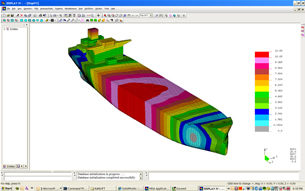 Supertanker for transporting crude oil. |
Marking improvements over the previous version of NISA, Cranes Software, Inc. (Troy,MI) released NISA Version 16.0 from NISA Software. Version 16.0, which comes with more than 50 new features, is described as comprehensive finite element analysis (FEA) software that provides solutions in stress analysis, seismic analysis, vibration analysis, composite material analysis, fatigue analysis, thermal analysis, printed circuit board (PCB) analysis, computational fluid dynamics (CFD), electromagnetic analysis, and civil structure analysis.
“Of particular interest to engineers is the ease of use with which NISA now operates within the CAD/CAE environment. In NISA Version 16.0, new and enhanced CAD Translators allow broad interoperability with common CAD systems.” |
Version 16.0 offers a completely integrated pre- and postprocessing environment within a state-of-the-art graphical user interface. It is said to offer seamless interoperability with most commercial CAD software, and is designed to meet the needs of the automotive, aerospace, energy and power, oil and gas, electronics packaging, and mechanical and civil engineering industries.
Version 16’s Automesher has been enhanced to support multi-body meshing — with a provision to assign a different material and property ID for each part. Users of NISA and third-party FEA product developers can integrate features and functionalities of their choice into the NISA DISPLAY interactive graphics pre- and postprocessor to extend its capabilities.
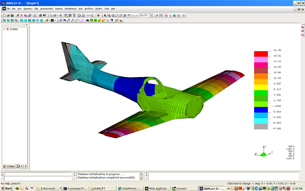 Single engine all-composite airplane. |
Plus, a shared memory parallel sparse matrix system equation solver (PARDISO from Intel) is introduced for the first time for structural, heat, fluid, electromagnetic analysis, and direct frequency response analysis is supported to obtain frequency response (for high-frequency applications).
What Makes NISA Stand Out
“Of particular interest to engineers is the ease of use with which NISA now operates within the CAD/CAE environment,” says Vipul Kinariwala, NISA Product Manager. “In NISA Version 16.0, new and enhanced CAD translators allow broad interoperability with common CAD systems. The new COM Style plug-in allows for compatibility with SolidWorks2008, support for Sketch Entities, enhanced healing of geometry edges and slivers. CAD support is also extended to Siemens UGS PLM Software, Autodesk Inventor, CATIA V4/V5, Pro/E, STEP, and IGES files.”
Kinariwala adds, “NISA has been updated to include a Multi-Core solver to enhance the speed of Static, Eigenvalue, and Direct Transient Analyses. This advancement allows NISA to run in parallel on computers with multiple cores or multiple CPUs, which dramatically improves turnaround times and performance.”
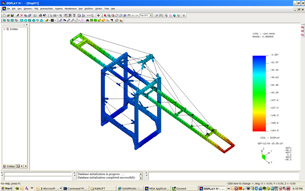 Crane for loading and unloading containers. |
The faster multicore solver in NISA 16.0, introduced for the structural, fluid, heat, and electromagnetic modules, is one of the many new enhancements in Version 16.0. Plus, enhancements in nonlinear static analysis capabilities offer improvements in 3D contact element with friction and introduction of concrete element. From an applications perspective, the company has included a new Element and Material Model to support nonlinear analysis solutions for concrete structures and it has updated the torsional spring elements to be compatible with nonlinear static and dynamic analysis.
The CAD Interfaces module now supports STEP, UG, and Inventor formats with enhancements offered in healing. Plus, the popular COM Style plug-in development framework has been included in DISPLAY IV, and the macro functionality in DISPLAY has been enhanced to better support parametric modeling. And for those interested in multi-physics analysis, a 2D-Mock fluid element has been introduced, suited for applications like fluid sloshing and other fluid-structure interactions.
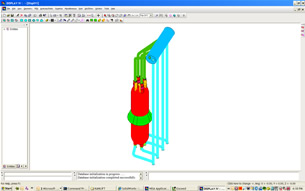 Pressure vessel assembly for nuclear application. |
The company says an upcoming Version 16.1, scheduled for mid-December release, will offer more advanced meshing capabilities for the automatic generation of surface and solid elements.
One Dozen Modules
The range in price, from approximately $7,000 to $16,000, is due to the fact that NISA is sold in modules. The base module, which includes the pre- and postprocessing program, static analysis (linear and nonlinear), and all CAD interfaces, is priced at $ 7,000 for a perpetual license. Users can then add additional modules as needed.
Specifically, Cranes Software offers 12 modules for mechanical applications (see link below for links to each of these apps). They include DISPLAY IV, the interactive graphics pre- and postprocessor, which supports OpenGL 3D graphics for enhanced dynamic viewing, shading, lighting, and animation.
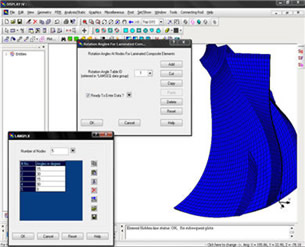 |
NISA II, the second module in NISA 16.0, is the parent program of the NISA family. It offers linear, nonlinear static, dynamic analysis features complemented with a finite element library. NISA II offers efficient solvers like direct (frontal and sparse) and iterative solvers as well.
NISA II/COMPOSITE, part of NISA II, is tailored for accurate and efficient analysis of composite structures using state-of-the-art solution methods, convergence techniques, and time integration schemes, says the company. NISA-ENDURE is general-purpose software for analyzing the fatigue performance and fracture characteristics of engineering structures and components.
The three programs in the NISAOPT family — STROPT, Shape, and SECOPT — provide capabilities for optimizing structural design and all are fully integrated with NISA II and DISPLAY III/IV.
- STROPT enables you to minimize material volume, mass, and weight for fixed geometry by changing thickness of shell, layer orientation angles, and thickness of composite laminate and cross-sectional dimensions of beams/bars.
- Shape lets you optimize structural shapes fully based on initial finite element model, without modeling boundaries by parametric curve.
- SECOPT provides beam cross-section optimization capabilities.
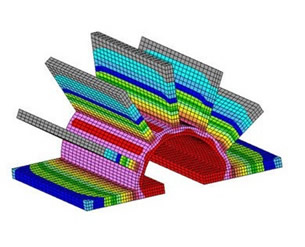 |
NISA/Heat is a general-purpose finite element program to analyze the spectrum of problems encountered in heat transfer. NISA/3D-FLUID is a general-purpose finite element-based CFD code for analyzing fluid flow and heat transfer problems. FEAP is a finite element program for the stress, random vibration, fatigue life, 3D convective fluid flow, and thermal analysis of printed circuit boards (PCBs) and electronic systems. EMAG is the electromagnetic module of the general-purpose finite element-based program NISA. It determines electric and magnetic field distributions in a wide class of electromagnetic devices.
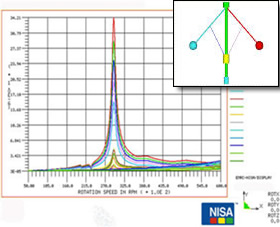 |
NISA/ROTOR, a new member of NISA family of finite element programs, offers CAE-based solutions for a variety of problems encountered in the dynamic analysis of rotor-bearing systems. DYMES is a general-purpose program for static, kinematic, and dynamic analyses of constrained multibody mechanical systems undergoing large, nonlinear 3D displacements.
And to facilitate the integration of analysis with CAD, the company offers a slew of data-exchange capabilities. They take one of the two forms: either direct CAD system interfaces, implemented by a menu command within a CAD program, or indirect data exchange interfaces, provided by various data translators or built-in commands of DISPLAY III/IV. Data conversion takes place in a manner that is transparent to the user.
 The dynamic analysis area has been enhanced from prior versions by inclusion of Multiple Support Excitation with missing mass correction for Frequency, Random, and Transient dynamic analyses to handle non-uniform support excitations. Having this capability allows users to perform seismic analysis according to Nuclear Regulatory Commission (NRC) codes for facilities and structures.
The dynamic analysis area has been enhanced from prior versions by inclusion of Multiple Support Excitation with missing mass correction for Frequency, Random, and Transient dynamic analyses to handle non-uniform support excitations. Having this capability allows users to perform seismic analysis according to Nuclear Regulatory Commission (NRC) codes for facilities and structures.
Developments for Greater Productivity
These developments in NISA further CAD interoperability as well as multiphysicscapability, and demonstrate the company’s commitment to enhancing productivityas well as preparing for future technologies, in which the company conductsresearch and development (R&D).
“We are very happy to announce the release of NISA Version 16.0 in both 32- and 64-bit versions,” said Pradeep Kumar, Sr. Vice President, CAE R&D Services, Cranes Software International Limited. “In this version we have carried forward the significant improvements we initiated in Version 15.0 with respect to interoperability and performance, and extension of support for additional CAD formats.”
“Introduction of assembly meshing with contact element generation has given automated meshing of CAD geometries a major boost,” he said. “In line with our commitment to open the NISA architecture, we have introduced the popular COM style plug-in development framework in DISPLAY IV. We strongly feel this will facilitate developer and third-party product company participation.”
Kumar added, “With this version we have extended multi-core solver support to our key modules — thus enabling shared memory cluster computing. We are optimistic these important developments will significantly increase the productivity of our customers.”
Company Offerings
NISA is available for a free evaluation, and Cranes Software maintains an online discussion board covering such topics as static/dynamic stress analysis, laminated composite analysis, fatigue and fracture analysis, heat and CFD analysis, electromagnetic analysis, CAD, 3D solid and surface modeling, pre- and postprocessing, and more.
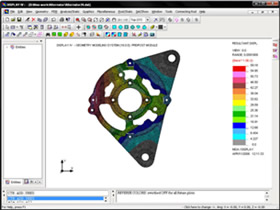 | 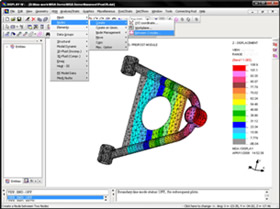 |
In addition to NISA, Cranes Software, Inc., which reports 350,000 users in 39 countries, also offers SYSTAT, SigmaPlot, SigmaStat, SigmaScan, TableCurve 2D, TableCurve 3D, PeakFit, eta/DYNAFORM, eta/VPG, XID, XIP, Survey ASYST, iCapella, InventX, and products from principals such as Livermore Software Technology Corporation, The MathWorks, Texas Instruments, and IBM.
Cranes Software is a subsidiary of Cranes Software International Limited, a provider of enterprise statistical analytics and engineering simulation software products, solutions, services, and R&D into future technologies.
As Kumar points out above about this version of NISA, the “introduction of assembly meshing with contact element generation has given automated meshing of CAD geometries a major boost.” And with the next version, 16.1, scheduled for release shortly, we are told we can expect even more advanced meshing capabilities for the automatic generation of surface and solid elements.
For further information on NISA Version 16, please visit NISA Software.
Read why DE’s editors chose this as a Pick of the Week.
Read more about the 12 NISA modules for mechanical applications (each of these links has a summary and offers downloadable pdf brochures).
For a CD or to download a free evaluation of NISA, please visit NISA Software.
Log on to NISA’s Discussion Board to read info from other users.
Register for training and webcasts at NISA’s website.
View current newsletters or sign up to receive the NISA Newsletter.
Cranes Software offers several mechanical application case studies.
To visit the company directly, go to Cranes Software, Inc.
For recent coverage by DE, see “Cranes Software Releases NISA Version 16.0,” (Oct 2008).
Margaret S. Gurney is the editor for new products at Desktop Engineering magazine.
Subscribe to our FREE magazine, FREE email newsletters or both!
Latest News
About the Author
DE’s editors contribute news and new product announcements to Digital Engineering.
Press releases may be sent to them via [email protected].






